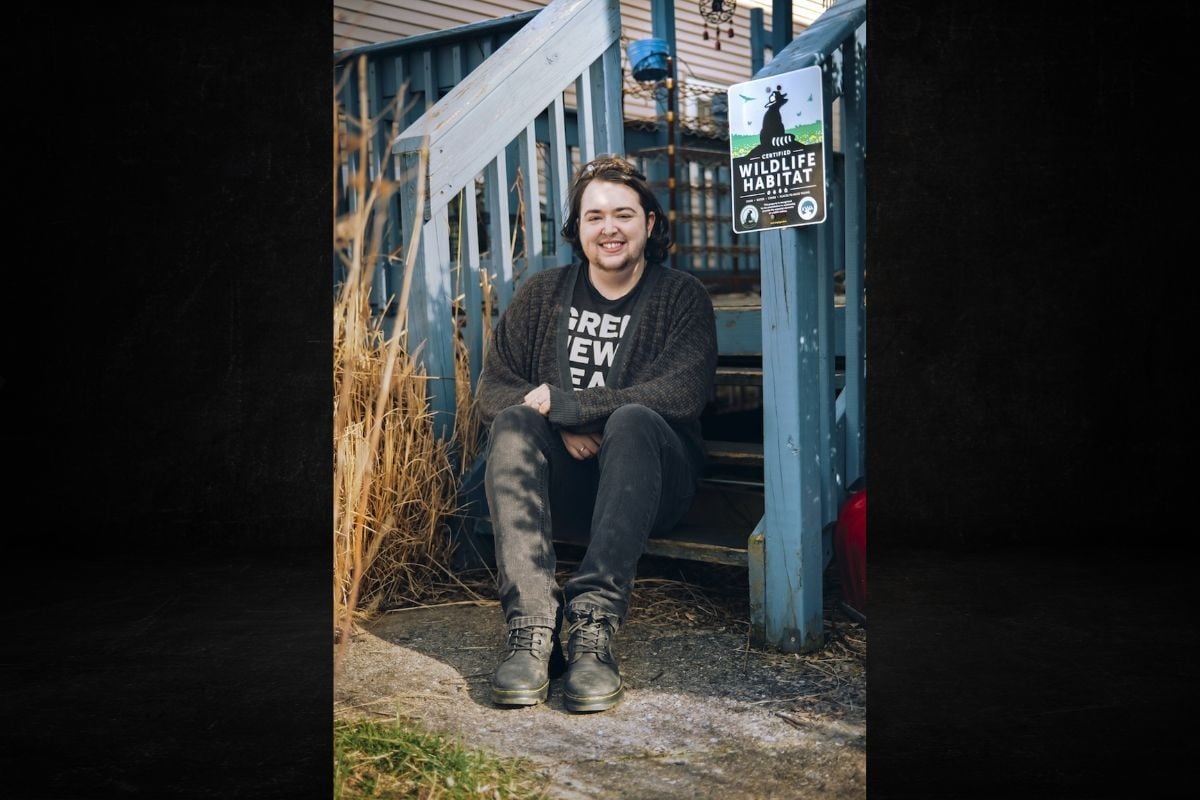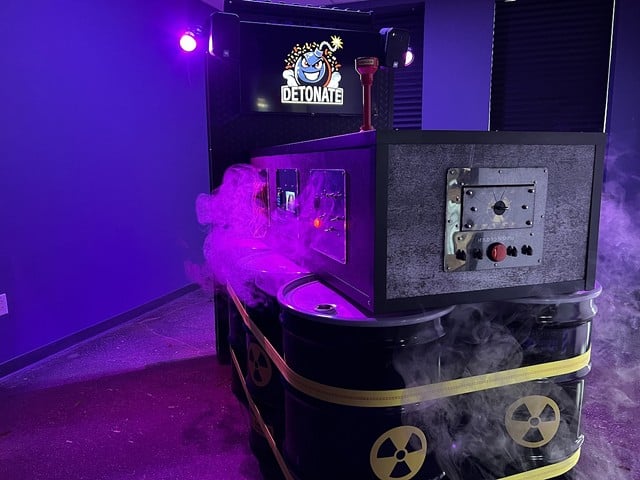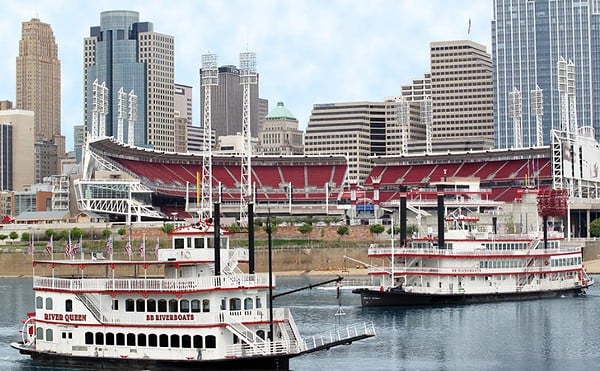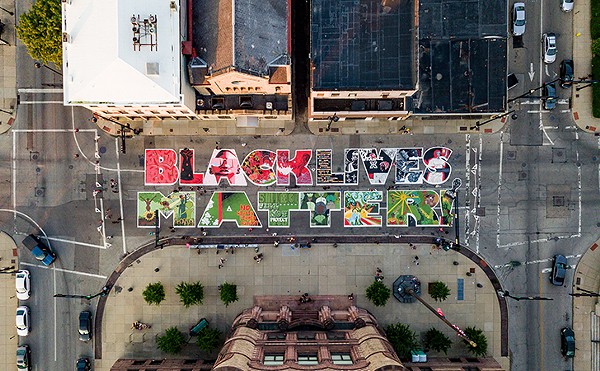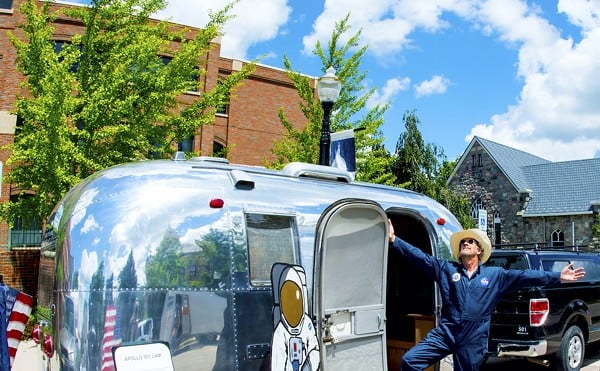This story is featured in CityBeat's April 3 print edition.
With spring officially in bloom and temperatures already reaching the 70s in Cincinnati, you may be itching to trim up your lawn to get that perfectly manicured look. However, you may want to re-channel that landscaping energy in a new way for the sake of the planet.
According to Tory Erpenbeck, sustainable design expert and the face behind Northern Kentucky’s Native Yardening, our yards actually play a powerful role in climate change, with traditional North American lawn upkeep posing a serious threat to Earth’s future.
While yards have traditionally stood as a status symbol for many people across the globe, Native Yardening seeks to change the status quo for private green spaces to mitigate their harmful impact on the environment.
“Before we industrialized everything, there wasn’t just grass that’s an inch high because it’s code,” Erpenbeck tells CityBeat. “There are a lot of living things that aren’t humans needing spaces that are not just an inch of grass. When we take it away, they die. And that’s why we’re here — currently in one of the largest mass extinction events that’s ever happened on the planet. And lawns have contributed to that.”
There have been five mass extinction events in Earth’s existence, defined by scientists as losing 75% of the world’s species in a short period of geological time — less than 2.8 million years, according to the Natural History Museum.
With nearly half of the planet’s animal species in decline, the world’s leading environmental watchdogs generally agree we are in the midst of a sixth mass extinction event, according to a study published in Cambridge Philosophical Society’s Biological Review. But, unlike all of the other mass extinctions, the cause of this one is entirely based on the actions of one species: humans.
“What’s happening right now is largely human-made,” says Erpenbeck. “While there is some natural cycle to it, we are really exacerbating it and accelerating it to a point where it’s going to wipe out everything.”
So what is the correlation between our yards and climate change? And what do we have to do with it? Can we stop it? Native Yardening first digs into why he feels it’s not an issue well-known to the larger public.
The laws around lawns
In Cincinnati and cities all across the nation, the laws governing our yards have effectively blinded homeowners to the harm their lawns are causing, according to the Native Yardening founder.
“A freshly cut lawn...it’s policy; it’s law,” Erpenbeck says. “So people don’t think about it. The climate crisis, versus being marketed as a problem that affects every single person on the entire planet, it’s been an us versus them political play, which is not an effective way to get people to care.”
In Cincinnati in particular, one law prohibits weeds or turf grasses from growing higher than ten inches in height. Failure to comply results in a fine, with each day of “violation” regarded as its own new offense.
And the limitations for those who belong to an HOA, or homeowners association, get even more strict. HOA guidelines for yards range from property being covered by at least 80% grass to nothing resembling a garden visible from the street. They often dictate what types of plants are acceptable, with anything that attracts wildlife often off-limits.
While it varies from one association to another, even within the same zip code, HOAs in general strive for a highly uniform look and traditional curb appeal that bans anything that could veer on the side of “unappealing.”
In a study on the early history of American landscape design by the National Gallery of Art, these preferences date back to 18th-century travel accounts and periodicals, with comments on the “appearance of a well-kept yard as a sign of its owner’s prosperity and responsible management,” cites the NGA.
With the amount of land lawns occupy in the United States equal to the size of Minnesota (about 128,000 sq km), their counterintuitive effect on biodiversity is affecting the globe at large.
How Native Yardening is taking action
With a fresh master’s degree in sustainable design in hand, experience growing native plants, a marketing background and a genuine passion for sustainability — thus the degree — Erpenbeck started Native Yardening.
“How can I implement this knowledge to make a change in the world — to educate people about all of the problems with lawns?” Erpenbeck asks. “There are so many problems with them, and people just don’t know.”
Starting off as a project on the environmental impact of lawns, an Instagram account Erpenbeck created to share his findings proved to be a success, which led him to make Native Yardening a full-fledged business.
A regenerative landscape consulting business, Native Yardening uses education and actionable steps to help others convert their yards into ecological gardens that heal the planet, rather than harm it. Though based in Northern Kentucky, Native Yardening specializes in land all across North America and is heavily web-based, striving to make his business and regenerative gardening in general accessible for all.
Among the heaps of freebies Native Yardening offers via its website, newsletters and Instagram account, you can book an in-person or virtual consultation, purchase downloadable content like guides and workbooks, or take the all-encompassing “Gardening for the Future” course. This online course is self-paced, allowing participants to go back to reference the information at any time — something Erpenbeck feels is the key to success in a process that can feel overwhelming at times.
Erpenbeck is guided by what he calls regenerative gardening, a term he took from regenerative agriculture.
“Basically, regenerative is leaving it better than you found it,” says Erpenbeck. “It’s working with nature versus against nature. And most people, when they’re landscaping, they’re working against nature.”
For the reason a majority of people use their yards counterintuitively (and why cities create laws that reinforce these bad practices), Erpenbeck points to the education system.
“It’s concerning how few people know anything about this, and that I had to go to graduate school to learn it. Very basic, how-nature-works 101. And there are so many things like that, where we’ve just been lied to by a very colonized, Eurocentric education system.”
Noting this as a systemic issue rather than an individual issue, Erpenbeck says it’s clear that for change to occur, we must take matters into our own hands.
“Obviously the climate crisis is not the fault of the individual, to make that clear. It’s the government and a very small handful of corporations that are ultimately at fault. But they’re also showing us that they don’t care, and they’re not going to fix it, and they’re going to keep making it worse. So we can’t rely on them to make the change,” says Erpenbeck.
How soil impacts the planet
According to the Native Yardening founder, the foundation to understanding how yards impact climate change is the key ingredient to healthy plants, and a topic he is happy to dig into: soil.
“Soil is my favorite thing to talk about. I’m a big fan of soil, because it is really, really, really misunderstood,” says Erpenbeck.
Even scientists have only very recently figured out how soil works, Erpenbeck says. Though it’s always been considered a chemical process, it’s revealed to be a very biological process, as well. But what is it about this biological process that’s impacting our climate?
It turns out there are three major ways soil contributes to the climate crisis — all caused by human error.
Carbon sequestration
Erpenbeck says one of the biggest contributing factors of how we got here is soil acting as a carbon sink, which is a natural or artificial reservoir that absorbs and stores the atmosphere's carbon.
When plants breathe in carbon dioxide (just like humans breathe in oxygen), they release that carbon dioxide, turn it into carbon and add it to the soil. Carbon is a lot safer in the soil than in the atmosphere, where it’s a greenhouse gas and contributes to global warming. Erpenbeck says the carbon ends up in the atmosphere when soil is disturbed through common lawn and farming practices, which have been normalized for centuries.
“When we disturb the soil through tilling or excessively digging or allowing it to erode, then the soil releases the carbon it’s been storing back into CO2 into the atmosphere where it contributes to the greenhouse effect,” he says.
The greenhouse effect is a natural process that occurs when gasses in Earth's atmosphere trap the sun's heat, according to NASA. While the natural greenhouse effect helps to make our planet a comfortable place to live, NASA has observed increases in the amount of carbon dioxide and other greenhouse gasses in Earth’s atmosphere caused by humans burning fossil fuels, which puts more carbon dioxide into our atmosphere. Too much of these gasses causes our atmosphere to trap more and more heat, warming the Earth even more.
Ocean acidification
The next way soil contributes to climate change is through ocean acidification, which is a reduction in the pH of the ocean over an extended period of time, according to the National Oceanic and Atmospheric Administration.
Ocean acidification is primarily caused by increasing levels of carbon dioxide in the atmosphere, but Erpenbeck points to sediment runoff from soil erosion into oceans that indirectly impacts the oceans’ pH levels.
“So much soil has eroded off of the land into the ocean that it’s changing the pH of the water, and that is one of a couple factors that are killing the coral reefs, which produce about half of the oxygen on the planet,” Erpenbeck says. “We can’t allow all of our soil to go into the ocean when it’s supposed to be on the land.”
Protecting coral reefs may be vital to our future, with a study by Princeton University proving the planet’s oxygen levels are at a steady decline.
Water retention
The third way soil is impacting climate change is through water retention or, rather, a lack thereof.
“Soil is not supposed to puddle,” says Erpenbeck. “It’s supposed to be able to absorb crazy amounts of water — like, so much water. And it just stays there and is available to the plants as they need it. So even in a place where there’s drought, there’s still a reserve of water and the plants can still continue to live.”
Erpenbeck says the reason soil isn’t retaining water is due to a lack of organic matter, or matter that has come from a recently living organism.
“All of the nutrients that plant [or animal] absorbed cycles back into the soil as it decomposes,” he says. “Because the soil doesn’t have the organic matter it needs to retain the water, it’s sort of like the carbon dioxide thing where then the water evaporates and goes into the atmosphere.”
The issue with more and more water vapor in the atmosphere, according to Erpenbeck, is how it impacts our weather.
“It leads to an increase in the frequency and severity of storms and hurricanes and all the weather events we’re seeing and will continue to see more,” Erpenbeck says.
The truth about common lawn practices and standards
Beyond soil, there are a number of common practices and standards surrounding lawns actually counterintuitive to a healthy ecosystem.
Leaf litter
If you left your leaves alone during the fall and winter, you’re already ahead of the curve for this widely performed practice.
“Leaf litter is a big one,” Erpenbeck says. “Along with it being important for the soil, it is very important for wildlife, because a lot of insects over winter make their nests in leaf litter.”
Small mammals like chipmunks will line their winter den with leaf litter to insulate it to keep themselves warm, according to Erpenbeck. He says amphibians and reptiles will also furrow into leaves to keep themselves moist. Birds also eat insects like caterpillars that are born inside the leaf litter. He says insects are widely impacted by less leaves on the ground.
“The reason we don’t see lightning bugs anymore is because they nest in leaf litter. I was able in just two years to have a booming lightning bug population in my yard just from leaving the leaves,” he says.
More than having a soft spot for animals and beloved bugs, providing a habitat for wildlife plays directly into the food chain.
“They are the basic foundations of everything else to live, including our food, because they pollinate our food crops, or something eats it that eats that, which goes into the animals we eat,” he says.
Plus, Erpenbeck says when leaves and wildlife decompose, their organic matter contributes to a healthy soil microbiome.
“The microbiome of the soil is what makes the soil actually work and what makes healthy, good soil that will grow healthy, thriving plants that don’t get attacked by pests and things,” he says. “The microbes need that organic matter as their food and shelter, basically. And they also break it down to turn it into soil.”
One of the easiest changes lawn owners can make for the betterment of the ecosystem, according to Erpenbeck, is simply letting falling leaves lie.
"Leaving them alone makes all the difference," he says.
And if your city or HOA mandates leaf cleanup for the sake of tidiness, consider relocating your leaves to your backyard. At the very least, consider eco-friendly alternatives to plastic when bagging your leaves and avoid sending them to the landfill where they won’t decompose properly.
Turf grasses and invasive plants
There are no turf grasses native to North America, says Erpenbeck, which are the types of grass used for lawns, classified as areas of short, mown grass in a yard, garden or park. As it turns out, Kentucky Bluegrass isn’t even from Kentucky, but brought over from Europe and is on the state’s official invasive plants list.
“I’ve lived in Kentucky my whole life and was taught in school that Daniel Boone came to Kentucky and saw the bluegrass with the little blue flowers, and he named it that — and that’s just not true,” says Erpenbeck.
Traced back to the colonization of America, turf grasses were brought over by European settlers to feed their livestock, but eventually were adopted by the American middle class to signify wealth just as the upper class in England did, Erpenbeck tells CityBeat.
By the mid-1800s when America’s first suburbs appeared, these types of lawns became synonymous with the “American Dream,” not only serving as a popular concept but established as the new standard with policies to protect it.
Depending on non-native turf negatively impacts the environment in more ways than one; not only are the standard grasses in our yards not evolved to the specific conditions of our geographic location, but they are also likely to cause ecological harm and outcompete any native plants trying to grow, otherwise known as invasive species.
“The go-to rule of planting native in your yard, while obviously 100% would be ideal, is to have 70% native, 30% non-native,” Erpenbeck says. “But the stuff that isn’t native, it’s important to make sure it’s not invasive.”
Garden center chains, like Lowes and Home Depot, are known for selling a lot of invasive plants, says Erpenbeck. He suggests shoppers come prepared to do some light Googling while they shop.
“Search the name of the plant and native range or invasive and it’ll come up where it’s native to,” he says. “If it does come up that it’s native to Asia or Europe for example, then search invasive and see whether or not it’s invasive.”
Synthetic chemicals
On the topic of garden centers, the next common lawn practice of concern to Erpenbeck is the use of synthetic chemicals — something readily available in stores and widely accepted as the ideal choice for treating your yard.
“I personally think that to use pesticides or herbicides, you should need to take lots of classes and you should need to get a license,” he says. “You should not be able to go to garden centers and buy it — where they have shelves of Roundup. And it’s not even just bad for the lawn and wildlife; it’s bad for people. If you have to put a sign in your yard that says ‘not safe for kids and dogs,’ then you shouldn’t be using it.”
In a 2022 study conducted by a unit of the Centers for Disease Control and Prevention (CDC), experts found that 80% of people that they tested had glyphosate, the active ingredient in Roundup, in their urine, including children. The makers of Roundup have faced thousands of lawsuits in recent years from complainants who developed cancers, most commonly non-Hodgkin lymphoma, from using Roundup. Bayer, which purchased Roundup from the now-defunct Monsanto Company, has had to pay out more than $10 billion in damages, and more lawsuits are ongoing.
“These were not farm workers, these were just random citizens…because it’s in our drinking water,” Erpenbeck says. “When you spray your yard with anything — pesticides, herbicides, fertilizer — when it rains, everything that is sitting there runs off into the sewers and goes into our drinking water. So you’re not just hurting yourself; you’re hurting your neighbors, your community.”
In 2015, the World Health Organization (WHO) reclassified glyphosate as “probably carcinogenic to humans.” The WHO evaluation noted that glyphosate has the highest production volume of all herbicides, especially in agriculture.
“Plus, a lot of pesticides are systemic, which means they affect the entire plant including the pollen,” Erpenbeck says. “So you’re not just killing the aphids, you’re also killing the bees and the butterflies.”
If you’re using pesticides in the first place because your plant is being killed by bugs, Erpenbeck says the bugs aren’t the problem — the problem is that the plant isn’t healthy to begin with.
“Plants have immune systems just like animals, and if it was that easy — if bugs could just kill plants — there would not be plants anymore,” he says.
Before jumping to any conclusions, the Native Yardening founder recommends taking a closer look to reveal your plant’s true diagnosis.
“Figure out what the bug is, because there are invasive insects like Japanese beetles, but if you’re seeing bugs like caterpillars attacking your plant, you really need to work on your soil. And spraying things is not going to help your soil; it’s going to kill the microbiome.”
How we can use our yards for good
Luckily, all of these common mistakes can easily be fixed, according to Erpenbeck.
“If you are someone who has a yard that you’re able to do what you want with, I think it’s the most impactful thing an individual person can do,” he says.
Here are Native Yardening’s recommendations.
Convert your lawn into an ecological garden
While it may be easier in the fall and winter when everything is dormant, you can start killing your lawn any time of year. Erpenbeck says now is the time to get stuff in the ground — to start finding plants that are native or to get seeds.
If you decide to grow from seed, while the result is rewarding, you’ll need to keep in mind that for most plants in the Cincinnati area, the seeds need a cold stratification period, AKA tricking your seeds into thinking it’s winter.
“Don’t just buy seeds and put them in your yard and expect them to germinate; you can put them in your fridge for however long — it depends on the seeds and how long they need to be cold for — and they’ll germinate after that,” says Erpenbeck.
If you’re looking for seeds, you may have trouble finding those of native plants at garden center chains. Personally, Erpenbeck grows everything from seed, sourced from reputable nurseries that do not use pesticides. You can buy seeds directly from Native Yardening’s website, or he suggests visiting your local farmers market, like Findlay Market or the Bellevue Beach Park Farmers Market.
It’s okay to start small
For those who feel like converting your lawn is an all-or-nothing act, Erpenbeck stresses that it’s okay to start small. Or if you have a small yard or only a balcony to work worth, it still matters.
“If you have a big yard and you only have the time, energy or money to convert a 3’x3’ space, that is infinitely better than not. Because if everyone did that it would make a huge difference,” Erpenbeck says.
For those with invasive plants, he recommends pulling them up or taking a saw to bigger, unwieldy overgrowth like honeysuckle. For plants at ground level, you can usually smother them with cardboard or a tarp.
To decide where and when to get started exactly, Erpenbeck suggests prioritizing what will go to seed soonest. Going to seed simply means after a plant has flowered, since flowers make seeds, and you want to avoid your invasives from spreading seeds into your yard and continuing to take over. If it’s something that fruits, the seeds will be in there, he says.
A helpful component to this is identifying what plants you’re working with. As this can be difficult for novices and seasoned gardeners alike, a variety of apps like Pl@ntNet and iNaturalist are available that identify the plants for you through photos to smooth and speed up this process.
Once you’ve identified your plant, you’ll find out whether it’s annual, biennial or perennial. Where annual plants last for only one growing season, biennials last for two, and perennials last anywhere from three to hundreds of years.
“Some plants will start flowering earlier than others. The annuals will probably be the easiest to get if you can keep them from going to seed, cause they’re coming back from the seed and not from the actual plant.
But, to keep it simple, you can use this rule of thumb: “Any invasive plant that you see with flowers — get it before it’s done flowering,” Erpenbeck says.
Use white vinegar
When you need some extra help killing off the invasives in your yard, an incredible alternative you may already have lying around is white vinegar.
“White vinegar is a cure-all for a lot of things,” says Erpenbeck. “It’s a much safer alternative. You definitely want to try to target it because it will kill whatever’s there, but it doesn’t linger the way synthetic chemicals do, and it doesn’t hurt the soil, and it doesn’t harm us.”
Collect rainwater
Another easy way to take care of your yard is by collecting rainwater.
“I personally just put buckets underneath my gutters, but you can buy a rain barrel that’s 50+ gallons, and we get enough rain here where it’s very much worth doing. Then you can use that water to irrigate and it’s much better for your plants than our tap water,” Erpenbeck says.
Since the tap water we have here is hard water, Erpenbeck says it locks up roots and soil. He also notes that tap water is either treated with chlorine or chloramine with the purpose of killing microbes — something you want to avoid when you’re trying to farm the microbes in your soil.
“By collecting rainwater you’re saving water, which is always good, and your water bill will be less if you’re not irrigating with a sprinkler.”
With water laws handled at the state level, it is legal in both Ohio and Kentucky to collect rainwater, though this is not the case for all states.
Inherent benefits of converting your lawn
If not for the plants and the climate, planting native comes with numerous benefits that will save you time and money.
“Native plants, in general, do not need very much from you, because they evolved in our climate. They need the things that are here: the temperature, the amount of rain, et cetera. Once they’re established, you don’t really need to water them unless we get a bad drought,” Erpenbeck says.
Of course, if you get rid of your lawn, this means you won’t have to mow.
“People complain about it,” says Erpenbeck. “And mowing a lot of the time is gas-powered which isn’t good. You’re also chopping up any bugs or amphibians or reptiles — all sorts of little living things — with your lawnmower.”
Plus, planting native has positive health implications.
“If you’re working on your soil, you’re surrounding yourself with the microbiology that is very important to humans as well,” says Erpenbeck. “Your gut microbiome is responsible for your immune system and your mental health and so many things — and all of that is microbiology. You can take a probiotic or you can go touch dirt.”
If you plan on growing food, the benefits continue.
“You can grow vegetables that are so much better for you than anything you can buy at the store. And then you remove the cost because you can buy tomato seeds for a couple dollars and have more tomatoes than you could ever need for that whole growing season.”
“And you get to see butterflies — and who doesn’t like that?”
Why acting now is important
According to Erpenbeck, now is the time to act.
“We’re at a very pivotal point with the health of our planet,” he says. “I think people see climate change as something that’s gonna happen in the future, but it’s happening now and it’s going to get worse,”
But while this is a human-made problem, on the flip side of the same coin, it means we can just as easily make a positive change.
“It’s not over by any means, but we have to start caring and doing what we can. I think turning your yard into a place that is conserving ecology is the most impactful thing — it’s more impactful than not using straws or recycling; it makes a much more direct impact,” says Erpenbeck.
“The Earth is so resilient and there are solutions for all of it. So it’s not hopeless — I don’t ever want anyone to feel hopeless even though sometimes it’s hard not to — but there are solutions.”
It turns out that our yards are a powerful tool for fighting the climate crisis — we’ve just been using them wrong.
“We do have power to make a change,” Erpenbeck says. “And your yard can sequester carbon dioxide from the atmosphere. Your yard can help lightning bugs that are becoming threatened species or monarchs that are endangered — a little impact from a lot of people adds up.”
To learn more about Native Yardening, visit nativeyardening.com.

